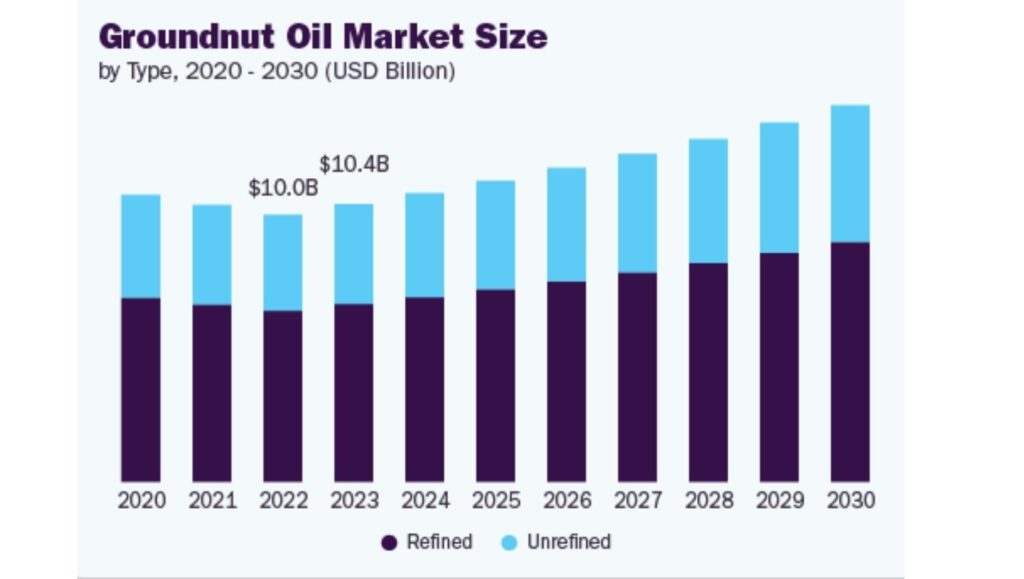In a global market increasingly defined by the demand for diverse and plant-based cooking oils, China has solidified its position as the largest groundnut oil producer in the world. The country’s dominance is underpinned by a vast domestic market, centuries-old culinary traditions, and sustained agricultural investment. While other nations, particularly India, remain major players, China’s sheer scale of production and consumption sets it apart.

The production of groundnut oil, also known as peanut oil, is a significant part of the global edible oils market. According to recent reports, China’s output consistently outpaces that of its competitors. This strong position is not only a reflection of its agricultural capacity but also of its deeply ingrained cultural preference for the oil’s distinct flavor and high smoke point, which makes it ideal for stir-frying and deep-frying.
The Agricultural Engine Behind China’s Groundnut Oil Production
China’s top ranking in groundnut oil production is a direct result of its extensive peanut cultivation. The country is the world’s largest producer of peanuts, with its farms yielding a staggering volume that forms the foundation of its oil industry. Provinces like Shandong, Henan, and Hebei are the epicenters of this production, benefiting from favorable climates and advanced farming techniques.
A significant portion of China’s peanut crop is crushed to produce oil, catering primarily to domestic consumption. Unlike many other commodities, the majority of groundnut oil produced in China is consumed within the country’s borders, with very little destined for the global export market. This high domestic usage rate reflects the oil’s status as a staple in Chinese households and a key ingredient in its vast foodservice sector. The nation’s agricultural policies and technological advancements, such as the use of high-yielding peanut varieties, have enabled it to maintain and even increase production despite global challenges.
Dr. Li Wei, a senior researcher at the Chinese Academy of Agricultural Sciences, noted that “the growth in China’s groundnut oil sector is driven by a two-pronged strategy: increasing the efficiency of peanut cultivation and meeting the rising demand from a health-conscious consumer base. The government’s focus on food security and self-sufficiency has made groundnut a strategic crop.”
India’s Pivotal Role and the Global Competition
While China leads, India is its closest rival and a formidable force in the global groundnut oil landscape. India consistently ranks as the second-largest producer of both peanuts and groundnut oil. The country’s production is concentrated in states such as Gujarat, Rajasthan, and Tamil Nadu, where groundnut farming is a traditional and vital part of the agricultural economy.
However, India’s groundnut oil industry operates with different dynamics. A significant portion of its production is also for domestic consumption, but it has a more notable presence in the global export market compared to China. India’s exports are driven by demand from countries with large Indian diaspora communities and those that value its unique flavor profile. The sector’s output can be more volatile, heavily influenced by the monsoon season, which determines the success of its major Kharif (summer) crop.

TABLE: Top Groundnut Oil Producing Countries (Recent Year Est.)
| Country | Estimated Production (Million Metric Tons) | Key Factors |
| China | 1.82 | Largest peanut cultivator, high domestic demand |
| India | 1.64 | Second-largest producer, significant domestic use and exports |
| Nigeria | 0.35 | Growing production, primarily for domestic market |
| Myanmar | 0.28 | Steady growth, local consumption |
| Senegal | 0.18 | Important exporter, particularly to the EU |
Note: Data represents estimates for a recent year and may vary slightly between sources.
Market Trends and Challenges
The global market for groundnut oil is influenced by a range of factors beyond just production volume. Groundnut oil‘s market position is shaped by its competition with other major vegetable oils, such as palm, soy, and sunflower oil. These alternatives often have lower production costs and can be more readily available, presenting a constant challenge to groundnut oil’s market share.
One of the key trends in the industry is the rising demand for cold-pressed and unrefined groundnut oil. Health-conscious consumers, particularly in developed markets, are increasingly seeking out oils that are minimally processed and retain more of their natural nutrients and flavor. This trend has created a niche market for premium products, where both Chinese and Indian producers are beginning to compete. The industry also faces significant challenges, including the unpredictability of agricultural yields due to climate change. Extreme weather events like droughts and floods can severely impact the peanut crop, leading to price volatility and supply chain disruptions. Additionally, concerns about peanut allergies remain a factor in consumer markets, which can influence a product’s appeal and regulatory landscape.
The export market for groundnut oil has its own set of leaders. While China and India are the production giants, countries like Argentina and Senegal are major exporters. Argentina, for instance, is a highly efficient producer that exports a large percentage of its groundnut oil output to the European Union and other markets. This specialization highlights the diverse strategies countries employ within the global groundnut oil trade.
In the end, China’s commanding lead in production is a story of meeting a colossal domestic appetite with an equally robust agricultural system. Its status as the largest groundnut oil producer is not merely a number but a reflection of its economic, agricultural, and cultural landscape. As the global edible oils market continues to evolve, China’s ability to maintain this position will depend on its capacity to adapt to environmental pressures and changing consumer tastes. The interplay between domestic consumption and international trade will continue to shape the future of this essential agricultural commodity.
Top Largest Broccoli Producer in the World: China and India Lead Global Market
